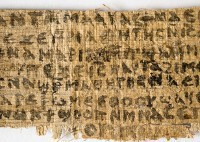Jesus Christ was married, papyrus says
Historians of religion and theologians have ongoing debates about whether Jesus was married to Mary Magdalene. The scientists' dispute was reflected in fiction and on screen, for example, "Da Vinci Code" by Dan Brown. Meanwhile, the debate is as old as Christianity itself, which is evidenced by the inscription on a Coptic papyrus.

Professor at Harvard Divinity School, Karen King in a dialogue about Jesus Christ with the Apostles discovered a documentary mention of his wife. "And Jesus said to them: my wife," said a small fragment of a Coptic papyrus dating back to the 5th century AD. The announcement was made in a report at the 10th International Congress of Coptic Studies in Rome.
Papyrus measuring 3.8 by 7.6 centimeters belongs to a private collector. On the one side it contains eight partial lines written by hand, and on the other side it has only three words and individual characters. The origin of the papyrus is unknown, but judging by the fact that the text was written in Coptic used by the early Christians, most likely it was found in Egypt. However, it is not ruled out that the copy was taken from an unknown Greek original written in the second half of the 2nd century, because it coincides with the recently studied apocryphal Gospel of Thomas, Mary and Philip.
The apocryphal Gospel of Philip found in 1945 at Nag Hammadi, says: "And the companion of [the Son - is Mary] Magdalene. [Lord loved Mary] more than [all] the disciples, and he [often] kissed her [mouth]. The rest of [the disciples, seeing] it [love] told him: "Why do you love her more than all of us?" The Savior answered them, "Why I do not love you like her?"
The words of his wife, according to the researcher, do not prove that Jesus was married. Kissing in the mouth is not so much evidence of erotic love as intimate knowledge transfer of the devoted worshiper. Also, the phrase suggests that in the 2nd century among early Christians there was no consensus on the question of whether Jesus was married and whether the followers of his teaching were better to marry or remain single.
Karen King is planning to publish the results of his research in the January issue of Harvard Theological Review. The draft of this work along with the images of the fragments found in English is available at the Harvard Divinity School.
In the four canonical gospels recognized by the Council of Nicaea in 325 as divinely inspired, Mary Magdalene appears in the same capacity as the other actors of the "Good News." However, the text does not reveal why she was so close to the Messiah. Equal to the Apostles in the Orthodox Church, Mary Magdalene came from Magdala in Galilee, near the town of Capernaum, and was named after it. Jesus healed her of evil spirits and, according to the evangelist Luke, out of sense of gratitude she joined one of the few pious women who accompanied the Lord everywhere during his earthly life. During the God-man's suffering on the cross, Mary Magdalene stood at some distance from the foot of the cross, and was present at the burial.
Mary Magdalene was the first one to see the risen Savior, and the first to hear the command of the Master to the apostles to tell them that he has risen from the dead. The crucified turned to her and said, "My wife, what are you crying for? Whom are you looking for?" Perhaps because her eyes were full of tears and deep sorrow because of the empty tomb, Mary first mistook Christ for someone else. And only then she recognized him by his voice, threw herself at his feet and said, "Rabboni - Master." The apostles did not believe Mary's testimony of the resurrection, attributing them to feminine fantasies.
According to a legend, Mary Magdalene preached the gospel in Rome, brought a complaint to the Roman emperor Tiberius about Pontius Pilate, and gave Caesar a red egg as a symbol of the suffering and resurrection of the Lord. Mary was buried at Ephesus, where in the 7th century her tomb was showed. Mary Magdalene's relics were transferred from Ephesus to Constantinople in 886 under the Byzantine emperor Leo the Wise. The harlot and the sinner was suddenly recognized by the Catholic Church as a saint, she was dedicated a holiday to and given the status of the "mystical bride of Christ."
In the most ancient of the New Testament an echo of the former debate about marriage is found. For example, in the Acts of Paul drawn up about year 150, the Apostle (or one who speaks on his behalf) preaches celibacy and divorce, claiming that only those who preserve the purity of the body, for they will become the place of God, are happy. At first, "Christian women" were accepted as legitimate wives, but soon Fathers chose a different interpretation.
Tertullian in the 2nd century saw "the wives of the Christians" as companions and servants, and not spouses. However, he admitted that Peter was married as his mother-in-law was referenced. Peter denied his Master three times, while Mary Magdalene was present at his death and the grave.
Igor Bukker
Pravda.Ru
Subscribe to Pravda.Ru Telegram channel, Facebook, RSS!





